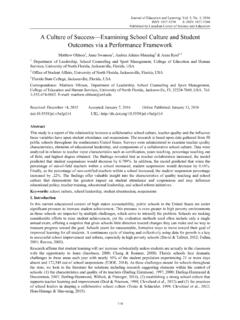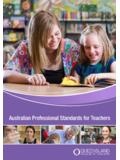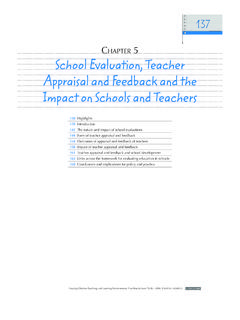Transcription of A SUMMARY OF THE EVIDENCE ON INCLUSIVE EDUCATION
1 A SUMMARY OF THE EVIDENCE ON INCLUSIVE EDUCATION PREPARED FOR:Instituto AlanaRua. Fradique Coutinho,50, 11o. andar, PinherosS o Paulo / SUBMITTED BY:Dr. Thomas Hehir,Silvana and Christopher Pascucci Professor of Practice in Learning Differences at the Harvard Graduate school of EducationIN PARTNERSHIP WITH:Abt Associates 55 Wheeler StreetCambridge, MA 2016Dr. Thomas HehirDr. Todd GrindalBrian FreemanRen e LamoreauYolanda BorquayeSamantha BurkeA SUMMARY OF THE EVIDENCE ON INCLUSIVE EDUCATION Abt Associates | A SUMMARY OF THE EVIDENCE ON INCLUSIVE EDUCATION1 CONTENTSI ntroduction.
2 2An International Movement Towards Inclusion ..4 Benefits of INCLUSIVE EDUCATION for Non-Disabled Students ..7 Non-disabled students can benefit academically from inclusion ..7 Inclusion can support the social and emotional development of non-disabled students ..12 Benefits of INCLUSIVE EDUCATION for Students with Disabilities ..13 Included students with disabilities academically outperform segregated students ..13 Students with Down syndrome benefit academically from inclusion ..16 Inclusion can support the social and emotional development of students with disabilities ..18 Considerations in Implementing INCLUSIVE EDUCATION .
3 19 Teacher attitudes and expectations ..19 Effective inclusion of students with Down syndrome ..20A Coordinated National Approach to Fostering Inclusion ..22 Establish an expectation for inclusion in public policy ..22 Establish a public campaign to promote INCLUSIVE EDUCATION ..22 Build systems of data collection ..23 Provide educators with a robust program of pre-service and in-service preparation on INCLUSIVE EDUCATION ..23 Create model universally designed INCLUSIVE schools ..24 Promote INCLUSIVE opportunities in both post-secondary school and the labor market.. 25 Provide support and training to parents seeking INCLUSIVE EDUCATION for their children.
4 25 Conclusion ..26 References ..28 Abt Associates | A SUMMARY OF THE EVIDENCE ON INCLUSIVE EDUCATION2 IntroductionAcross the globe, students with disabilities are increasingly educated alongside their non-disabled peers in a practice known as inclusion. Inclusion is prominently featured in a number of international declarations, national laws, and EDUCATION policies. These policies, coupled with the efforts of advocates for the rights of people with disabilities, have led to a substantial increase in the number of students with disabilities who receive schooling alongside their non-disabled this report we sought to identify research that demonstrates the benefits of INCLUSIVE EDUCATION not only for students with disabilities, but especially for students without disabilities, since EVIDENCE of benefits for the former is already widely known.
5 This report is the result of a systematic review of 280 studies from 25 countries. Eighty-nine of the studies provide relevant scientific EVIDENCE and were synthesized and summarized is clear and consistent EVIDENCE that INCLUSIVE educational settings can confer substantial short- and long-term benefits for students with and without disabilities. A large body of research indicates that included students develop stronger skills in reading and mathematics, have higher rates of attendance, are less likely to have behavioral problems, and are more likely to complete secondary school than students who have not been included.
6 As adults, students with disabilities who have been included are more likely to be enrolled in post-secondary EDUCATION , and to be employed or living independently. Among children with Down syndrome, there is EVIDENCE that the amount of time spent with typically developing peers is associated with a range of academic and social benefits, such as improved memory and stronger language and literacy students with disabilities can support improvements in teaching practice that benefit all students. Effectively including a student with a disability requires teachers and school administrators to develop capacities to support the individual strengths and needs of every student, not just those students with disabilities.
7 Research EVIDENCE suggests that, in most cases, being educated alongside a student with a disability does not lead to adverse effects for non-disabled children. On the contrary, some research indicates that non-disabled students who are educated in INCLUSIVE classrooms hold less prejudicial views and are more accepting of people who are different from people without disabilities, the benefits of inclusion extend into the workplace. In a study of Brazilian, Spanish, United States, and Canadian companies and institutions, McKinsey & Company researchers found that employing people with Down syndrome creates a positive impact on a company s work culture and environment, fosters the development of conflict resolution skills, and increases the self-motivation of , many students with disabilities still struggle to access effective INCLUSIVE programs.
8 Long-standing misconceptions regarding the capacities of children with intellectual, physical, sensory, and learning disabilities lead some educators to continue to segregate disabled and non-disabled Associates | A SUMMARY OF THE EVIDENCE ON INCLUSIVE EDUCATION3 For the purposes of this study, INCLUSIVE EDUCATION is understood in contrast to other common educational environments for students with disabilities: exclusion, segregation and integration (see graphic). Inclusion involves a process of systemic reform embodying changes and modifications in content, teaching methods, approaches, structures and strategies in EDUCATION to overcome barriers with a vision serving to provide all students of the relevant age range with an equitable and participatory learning experience and environment that best corresponds to their requirements and preferences.
9 Placing students with disabilities within mainstream classes without accompanying structural changes to, for example, organisation, curriculum and teaching and learning strategies, does not constitute inclusion. Furthermore, integration does not automatically guarantee the transition from segregation to inclusion. What is inclusion? Educational environments for students with disabilities range from a complete denial of formal educational services to equal participation in all aspects of the EDUCATION system. For this paper, we describe the educational experiences of students with disabilities using the following four categories.
10 EXCLUSIONSEGREGATIONINTEGRATIONINCLUSION E xclusion occurs when students are directly or indirectly prevented from or denied access to EDUCATION in any occurs when the EDUCATION of students with disabilities is provided in separate environments designed or used to respond to a particular or various impairments, in isolation from students without is a process of placing persons with disabilities in existing mainstream educational institutions, as long as the former can adjust to the standardized requirements of such : United Nations Committee on the Rights of Persons with Disabilities General Comment No.

















